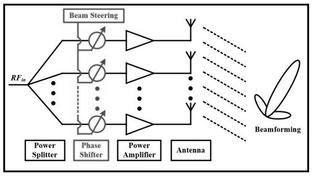Weather Radar Systems: A Comprehensive Overview
Advertisement
Okay, here’s the article converted into Markdown format, incorporating the instructions you provided:
Weather Radar Systems: A Comprehensive Overview
Weather radar systems are a crucial technology used to detect and monitor precipitation. Beyond just seeing rain, they are also vital for studying and predicting complex weather patterns and phenomena. Meteorologists and weather forecasters rely on them to determine a wide range of climatic conditions, including wind speed, cloud formations, and even sea water tides.

Similar to other radar systems, weather radar transmits radio frequency waves or microwaves. By analyzing the scattered pulse waves that return, it can determine various parameters related to the atmosphere. The “targets” it detects can range from raindrops and snowflakes to even bumblebees and hailstones!
Many modern weather radars utilize the Doppler effect to measure the motion (speed and direction) of precipitation particles. This capability is especially valuable. In fact, it’s this type of radar that assists pilots in navigating aircraft through thick clouds and conditions of poor visibility.
Typically, a weather radar system transmits radio waves at a frequency of approximately 3000 MHz (about 10 cm wavelength), sending out short pulses at a rate of about 1000 pulses per second.
Weather Radar Working Principle
Let’s delve into the weather radar’s diagram, components, and operational principles. The system consists of the following key elements:
- Transmitter
- Receiver
- Antenna system
- Feedhorn
- Radome
Here’s a breakdown of each component:
-
Transmitter: This includes RF signal generation modules such as a modulator, RF upconverter, and power amplifier.
-
Receiver: This incorporates RF signal analysis modules, including a Low-Noise Amplifier (LNA), RF downconverter, demodulator, and display.
-
Antenna: The antenna is used to both transmit the signal into the air and capture the returning RF signal from the atmosphere.
-
Feedhorn: The feedhorn focuses the received signal towards the receiver and directs the signal from the transmitter to the antenna for broadcasting into the air.
-
Radome: This protective structure shields the antenna and other subsystems from high-speed winds and other environmental factors.
-
Data Processing: Received signals undergo data processing to create a series of images called radar echoes or reflectivity maps.
-
Analysis: Meteorologists analyze the radar data to interpret various weather phenomena like rain, hail, snow, thunderstorms, and tornadoes.
Weather Radar Scanning Techniques
Scanning techniques allow meteorologists and research teams to observe various aspects of the atmosphere. This includes precipitation intensity, movement, and overall structure.

For meteorological applications, radar uses scanning techniques such as PPI and RHI.
-
Plan Position Indicator (PPI): In this mode, the radar maintains a fixed elevation angle and varies the azimuth angle. A 360-degree rotation is called a “surveillance scan,” while a rotation of less than 360 degrees is a “sector scan.”
-
Range Height Indicator (RHI): Here, the radar keeps its azimuth fixed and varies the elevation, rotating upwards towards the sky. Data from different elevation angles are collected over time for later analysis.
-
Volume Scan: This technique combines multiple PPI and RHI scans at different elevation angles to create a 3D view of the atmosphere.
-
Surveillance Scan: This involves regular PPI scans at different elevation angles to track the movement and intensity of precipitation across a wide area.
-
Doppler Scan: Doppler radar measures the velocity of precipitation particles by analyzing the frequency shift of radar waves reflected off of moving objects. This relies on the Doppler effect, mathematically expressed as:
where:
- is the observed frequency.
- is the emitted frequency.
- is the velocity of waves in the medium.
- is the velocity of the receiver relative to the medium.
- is the velocity of the source relative to the medium.
-
Dual Polarization Scan: The radar emits both horizontally and vertically polarized waves, helping meteorologists determine particle shape, size, and type.
-
Sector Scan: Instead of scanning the full 360 degrees, the radar focuses on a specific sector.
-
Adaptive Scan: Adaptable scanning strategies are used that adjust based on evolving weather conditions.
Benefits of Weather Radar
Here’s a look at the advantages and benefits of using weather radar systems:
-
Accurate Precipitation Detection: Weather radar can accurately detect the presence and intensity of different types of precipitation.
-
Severe Weather Tracking: It is instrumental in identifying and tracking severe weather phenomena.
-
Real-Time Information: Weather radar provides real-time information about the movement and evolution of storms.
-
Rainfall Estimation: It can estimate the amount of rainfall occurring in a specific area or region.
-
Water Cycle Observation: It plays a significant role in observing and modeling the Earth’s water cycle.
-
Aviation Safety: Weather radar provides useful information about wind shear, turbulence, and other weather conditions. This is especially useful at airports for aircraft during takeoff, landing, and in-flight operations.
-
Emergency Management: It aids in emergency management and in coordinating disaster response efforts.
-
Public Awareness: It helps communities stay informed about changing weather conditions and potential hazards.
Conclusion
Overall, weather radar systems are extremely useful in monitoring, understanding, and predicting weather patterns and severe weather events. They help meteorologists, emergency responders, and the general public make timely decisions based on real-time weather conditions.
Advertisement
 RF
RF

